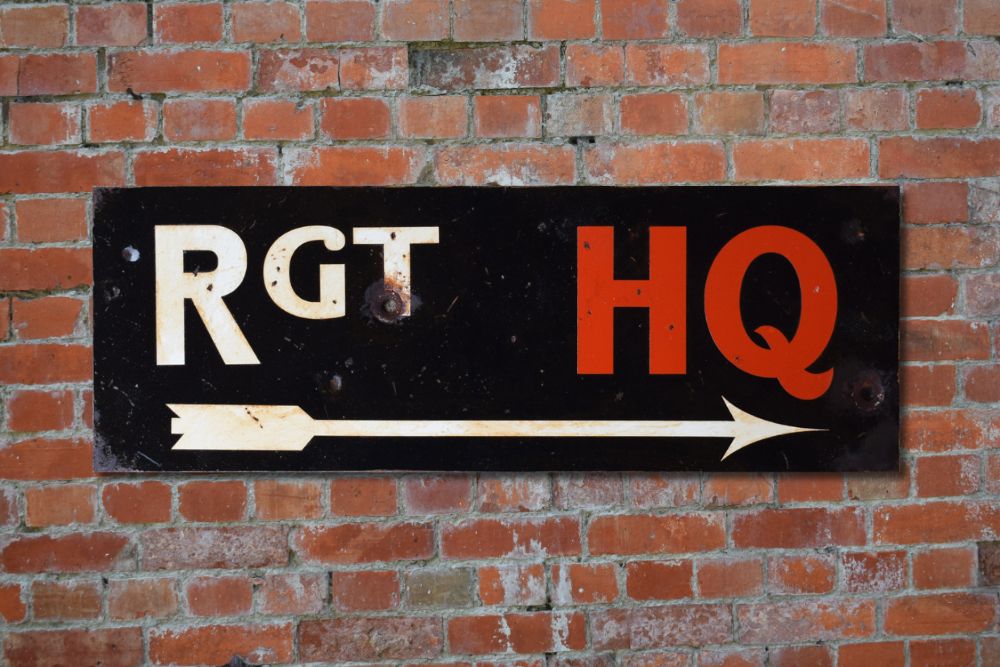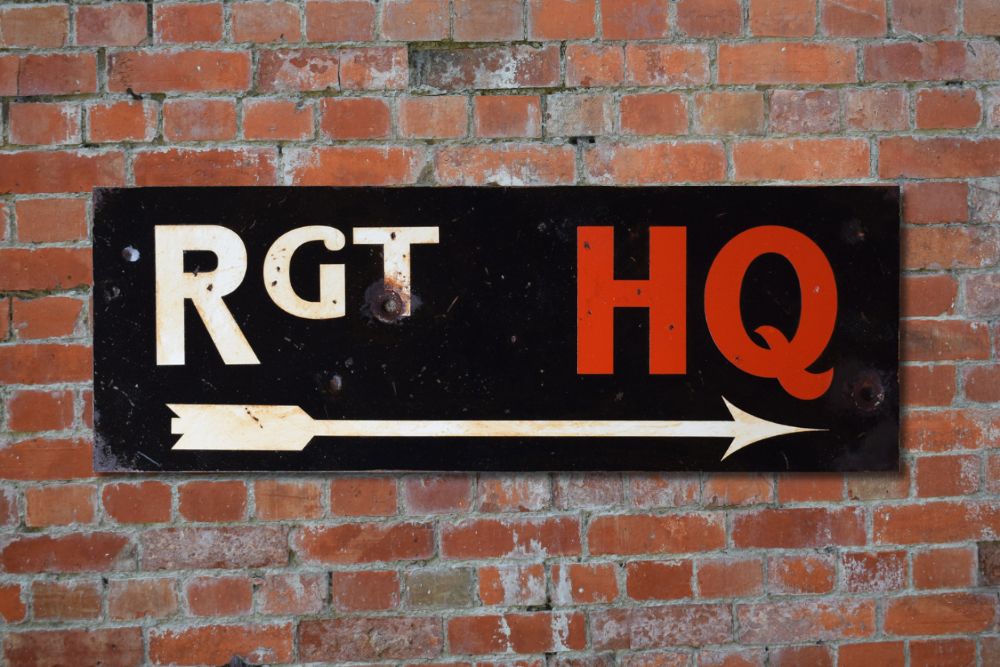
-
WWI - Regiment H.Q.
- Steel road sign. 833mm x 310mm.
- £79.95

Regiment H.Q.
Steel display sign 833mm x 312mm
The battalion was the standard operational unit of all British infantry during the Great War.
Each battalion belonged to a regiment. This was not an organisational matter except that the battalion had administrative links to the regiment’s depot and (until the system was substantially changed in 1916) would generally receive reinforcement drafts from training units belonging to the same regiment. The battalion’s regiment gave it a badge and insignia, tradition and history that was used as an important part in developing a soldier’s feeling of belonging and esprit de corps.
A battalion usually came under command of a brigade (often called an infantry brigade to distinguish it from a cavalry brigade). The principal exception to this was when certain battalions were designated as Pioneer.
The battalion was comprised of a headquarters, four companies and its transport. Until 1915 it also had a Machine Gun Section. At full establishment in 1914 it consisted of 1,007 men, of whom 30 were officers.
Battalion headquarters and transport
The battalion was usually commanded by a Lieutenant Colonel, with a Major was Second-in-Command. A Captain or Lieutenant filled the role of Adjutant (in charge of administration); a Captain or Lieutenant was the Quartermaster (responsible for stores and transport); an officer of the Royal Army Medical Corps was attached to work as the battalion’s Medical Officer. A Chaplain from the Army Chaplain’s Department was assigned.
Headquarters also included the Regimental Sergeant-Major (RSM, the most senior Non-Commissioned Officer) plus a number of specialist roles filled by Sergeants: Quartermaster, Drummer, Cook, Pioneer, Shoemaker, Transport, Signaller, Armourer (often attached from the Army Ordnance Corps) and Orderly Room Clerk. A Corporal and four Privates of the Royal Army Medical Corps were attached for sanitary and clean water duties; a Corporal and 15 Privates were employed as Signallers; 10 Privates were employed as pioneers (on construction, repair and general engineering duties); 11 Privates acted as drivers for the horse-drawn transport; 16 acted as stretcher-bearers (these often being the musicians of the battalion band); 6 Privates acted as officers’ batmen (personal servants) and two as orderlies for the Medical Officer.
Companies
The four companies were usually lettered A to D, although some battalions used 1 to 4 or W to Z. Each numbered 227 heads when at full establishment.
The company was commanded by a Major or Captain, with a Captain as Second-in-Command. Company HQ included a Company Sergeant-Major (CSM), a Company Quartermaster Sergeant (CQMS), two Privates acting as batmen and 3 as drivers.
The body of the company was divided into four Platoons, each of which was commanded by a subaltern (a Lieutenant or Second Lieutenant). The company consisted of 8 Sergeants, 10 Corporals, 4 Drummers, 4 Privates assigned as batmen and 188 Privates. Each Platoon was subdivided into four Sections.
Machine Gun Section
The section consisted of a Lieutenant (acting as Battalion Machine Gun Officer), a Sergeant, a Corporal, 2 drivers, a batman and 12 Privates trained in the maintenance, transport, loading and firing of the Vickers heavy machine gun. These men made up two six-man gun teams.
Battalion transport
The battalion had 13 riding and 43 draught and packhorses to draw its six ammunition carts, two water carts, three General Service Wagons (for tools and machine guns), and the Medical Officer’s Maltese Cart. The battalion signallers had 9 bicycles.
Roadspace
When it was deployed onto a road in regulation fashion, the battalion’s transport occupied 210 yards of road space, and the fighting portion (men marching with some officers mounted) a further 590 yards.
Changes during the war
The Machine Gun Sections were withdrawn from infantry battalions when the Machine Gun Corps came into existence, and in the case of most of the battalions already overseas this was implemented by the section being transferred to the MGC.
A series of developments changed the tactical organisation of the battalion. In 1914 the soldiers in a Platoon were essentially all riflemen, armed with the .303 inch SMLE rifle and sword bayonet.
British General Headquarters issued the key training pamphlet SS143 (“Instructions for the Training of Platoons for Offensive Action”) in February 1917. This implemented a new tactical structure based on learning gained in the recent Somme offensive. It is regarded as a key step in the development of the eventual war –winning “all arms” fighting. The Platoon would when going into attack be led by riflemen, with specialist rifle grenadiers and bombers (hand grenade men) in close support. Each Platoon would have a section armed with the light Lewis machine gun to provide supporting fire and to engage targets as they arose.
The composition of the platoon was now to be a Platoon HQ (an officer (subaltern) and four men), with a Rifle section, Rifle Grenade Section, Lewis Gun Section and a Bombing Section (each Section being one 1 NCO and eight men). The riflemen were also to be trained to use the rifle grenade and also to be able to move into the Lewis Gun or Bombing Section as need arose. The Bombing Section was to be composed of two specialist throwers, two bayonet men and two riflemen, with two others who carried supplies of bombs. They worked in concert, so for example when attacking an enemy pillbox the Lewis guns and rifle grenadiers keep it under fire while the riflemen and bombers work around the flanks and get behind it.
By 1918 all men were trained in the use of the hand and rifle grenade and specialist Bombing Sections disappeared. The Platoon was reorganised as three Sections (each armed with rifles, bayonets, grenades and rifle grenades and soldiers with flexible skills to use them all) and the Lewis Gun Section with two gun teams. Battalion HQ was also equipped with four Lewis guns.
The battalion’s overall firepower very greatly increased during the war, notably by the addition of 36 Lewis guns (two for each of the 16 Platoons plus four with Battalion HQ).
Battle experience also led to orders to ensure that battalions would leave behind a number of men when going into action, to form a nucleus for rebuilding, in the event of heavy casualties being suffered. A total of 108 all ranks, consisting of a mix of instructors, trained signallers and other specialists, were to be left out.
The number of men acting as stretcher-bearers was increased from 16 to 32.
Regulations reveal certain minor deviations from the standard composition. Battalions of the Scots Guards and the other Highland Regiments were allowed a Sergeant-Piper and five Pipers. Neither the Scottish Lowland or Irish Regiments were allowed this extra strength, although they did have Pipers from within the basic headcount shown above. This was also true of the Tyneside Scottish and Tyneside Irish (Service) Battalions of the Northumberland Fusiliers and even the London Scottish Territorials.
Battle reality
Once they had been overseas for a while it was rare indeed for a battalion to be at full establishment. It was not unknown at times for battalions with a nominal strength of over a 1000 men to go into fighting with perhaps only 200.
Equipment was lost and damaged, and not always replaced quickly or fully. Battalion subalterns and CQMS’s faced the brunt of continual Brigade and Divisional Staff questions about equipment state and availability. Lucky was the battalion with a wise Quartermaster who knew his way around the Lines of Communication, Brigade and even Engineers dumps and did not shy at “finding” equipment for his battalion.
Certain types of heavy equipment were eventually left in trenches and other positions, being handed over to the relieving unit in exchange for a chit describing the ‘trench stores’ they had received.
A typical battalion spent perhaps only 5-10 days in a year in intensive action; they would also spend 60-100 days in front-line trench activities without being in action, with the rest of the time being in reserve or at rest, both of which entailed continual effort on fatigues or training.
